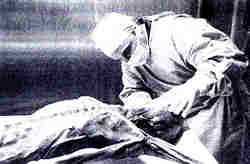If we knew the season in which the sloths died could that help tell us how they died? Does dying in the winter leave traces in fossils that dying in the summer doesn’t? The Iceman Murder case offers an intriguing idea for detecting freezing in fresh tissue. In 1983 Pennsylvania police found a corpse tightly wrapped in plastic bags dumped along a mountain road. Medical examiners performing the autopsy noticed an unusual pattern of decomposition and odor, and suggested to skeptical police that the victim had been kept frozen somewhere since he had disappeared over two years earlier. The examiners had spotted cavities in the victim’s tissues where the doctors hypothesized ice crystals had grow, distorting the surrounding tissue and leaving holes they called “ice crystal artifacts.” Their discovery eventually helped convict a New Jersey contract killer.
 I’m wondering: 1) Do ice crystal artifacts form in bone? 2) If so, what do the holes look like and can they be distinguished from the post-mortem recrystallization of apatite that also enlarges the cavities? 3) Is the warping of the bone by the ice different in fresh bone versus weathered bone ? 4) Can we distinguish immediate post-mortem freezing from ice artifacts that form in subsequent winters? 5) Would ice crystal artifacts be more likely in one particular bone? 6) Will a thin-section of the bone show them? 7) What other clues does dying in winter leave?
I’m wondering: 1) Do ice crystal artifacts form in bone? 2) If so, what do the holes look like and can they be distinguished from the post-mortem recrystallization of apatite that also enlarges the cavities? 3) Is the warping of the bone by the ice different in fresh bone versus weathered bone ? 4) Can we distinguish immediate post-mortem freezing from ice artifacts that form in subsequent winters? 5) Would ice crystal artifacts be more likely in one particular bone? 6) Will a thin-section of the bone show them? 7) What other clues does dying in winter leave?
References
Zugibe, FT and Costello, JT. 1993. The Iceman Murder: One of a series of contract murders. Journal of Forensic Science 38: 1404-1408.

I think that the freezing explanation is wide open for a volunteer project. I propose that we get a cow humerus from the meat market, have a student make a thin section at both ends, freeze it for at least a semester and then make another section for comparison. It should then go back into the freezer and come out again for annual checkups. I am sure that I can provide a weathered bison bone for parallel treatment. Does the museum have a volunteer that would be interested? Perhaps one of the dig volunteers would like to do this also. Better yet, some are deer hunters and probably have deer or elk that has been in a freezer for more than a year. That would be the fast track!
Good idea. We may not need to wait a year. I don’t think longevity in the freezer is going to contribute to crystal growth as much as SLOW temperature changes. Zugibe and Costello note that slow freezing AND thawing cause enormous ice crystal artifacts to grow. When pathologists do tissue thin-sections they use liquid nitrogen to rapidly freeze the sample and avoid ice crystals entirely. We may want to use a home freezer with an autodefrosting feature rather than our walk-in museum freezer. We’ll have to think about how we simulate the mass of the sloth, especially warming up. Fast thawing will defeat the purpose.
Holmes, I think I’ve got a deer leg or two still in the freezer from last year. These are from a car hit deer I put down in fall of 06 -it was a warm day so I couldn’t hang him -just quick quartered it and threw him in the deep freeze. I was thinking I’d roast them over the fire for some party this summer, but I could donate them for good science:) I’ve got the lower legs and feet of several bison I’ve butchered in the deep freeze too if you could use those.
– Pete